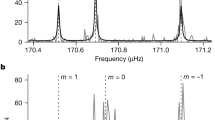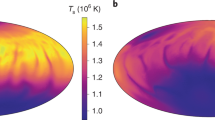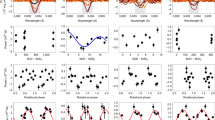Abstract
Many years ago Cowling1 discussed the possibility that the Sun has a significant relic field. This field would have poloidal and toroidal components, with the toroidal component being driven by dynamo action on the poloidal component. The toroidal field would be quadrupole in nature having opposite senses in the upper and lower hemispheres. Subsequently, Dicke2 proposed that the solar quadrupole moment is caused by a strong, inclined toroidal field with a magnitude of ∼6×107 G. Ulrich and Rhodes3 suggested that a poloidal field with a magnitude of 3 × 108 G was required to account for some of the properties of the 5-min period oscillation. Whereas Mestel and Moss4 claimed that such fields may not be sufficiently stable to endure. Hill et al.5 argued that solar oscillation data imply that a simple poloidal field is much weaker than 3 × 108 G and Gough6 has suggested that the toroidal field may be much weaker than the 6 × 107 G postulated by Dicke2. Magnetic fields, like rotation, produce a fine structure in solar oscillations. Their effects should be detectable provided the fields are sufficiently intense. Here we perform an analysis of oscillation data due to Hill et al.5 to show that limits of a few megagauss can be placed on poloidal and toroidal magnetic fields inside the Sun. A limit can thereby also be placed on the part of the quadrupole moment of the Sun due to magnetism. These fields are too weak to induce a quadrupole moment much larger than that which would result if the Sun rotated rigidly at the observed surface equatorial rate.
This is a preview of subscription content, access via your institution
Access options
Subscribe to this journal
Receive 51 print issues and online access
$199.00 per year
only $3.90 per issue
Buy this article
- Purchase on Springer Link
- Instant access to full article PDF
Prices may be subject to local taxes which are calculated during checkout
Similar content being viewed by others
References
Cowling, T. G. Mon. Not. R. astr. Soc. 105, 166 (1945).
Dicke, R. H. Solar Phys. 47, 475–515 (1976).
Ulrich, R. K. & Rhodes, E. J. Preprint, Univ. California, Los Angeles (1982).
Mestel, L. & Moss, D. L. Mon. Not. R. astr. Soc. 178, 27–49 (1977).
Hill, H. A., Bos, R. J. & Goode, P. R. Phys. Rev. Lett. 49, 1794–1797 (1982).
Gough, D. O. Nature 298, 350–354 (1982).
Frieman, E. & Rotenberg, M. Rev. mod. Phys. 32, 898–902 (1960).
Dziembowski, W. & Pamjatnykh, A. A. in Pleins feux sur la physique solaire (ed. Rosch, M. J.) 135 (CNRS, Paris, 1978).
Dicke, R. H. Nature 300, 693–697 (1982).
Dicke, R. H. in Proc. Informal Conf. on Status and Future of Solar Neutrino Research, Vol. 2 (ed. Friedlander, G.) 109–143 (Brookhaven National Laboratory, New York, 1978).
Author information
Authors and Affiliations
Rights and permissions
About this article
Cite this article
Dziembowski, W., Goode, P. Limits on the Sun's core magnetism from solar oscillations. Nature 305, 39–42 (1983). https://doi.org/10.1038/305039a0
Received:
Accepted:
Issue Date:
DOI: https://doi.org/10.1038/305039a0
This article is cited by
-
Magnetic field corrections to solar oscillation frequencies
Nature (1986)
-
Rotational splitting of global solar oscillations and its relevance to tests of general relativity
International Journal of Theoretical Physics (1984)
Comments
By submitting a comment you agree to abide by our Terms and Community Guidelines. If you find something abusive or that does not comply with our terms or guidelines please flag it as inappropriate.



